Thunder and lightning. Coffee and Monday mornings. Job levels and salary benchmarking.
All pairings where one without the other simply can’t function.
A solid level framework is a crucial foundation for consistent and fair compensation and career progression decisions.
There are many different types of level frameworks out there, with different companies having slightly differing job level structures to meet their needs. When it comes to salary benchmarking, this means there are a myriad of inconsistencies within the data, which makes it impossible to know if you’re truly comparing like-for-like with the market.
Because of this, levelling is always the first step when onboarding with Ravio: mapping your employees against the job levels we use within our compensation benchmarking data.
It’s also the crux of one of the most common questions we hear from the People and Reward Leaders we work with, who are keen to understand how this actually works – how does Ravio level my employees?
Why does Ravio level my employees?
The central purpose of a salary benchmarking tool like Ravio is to give you an accurate insight into what the wider market is paying for the roles within your org chart.
Job levels are a vital part of that: market-standard compensation for each role varies depending on level of seniority – a Head of Engineering, for instance, naturally earns more than a Junior Software Engineer.
Complications arise because different companies use different job titles and job levels. How can you be sure you’re comparing like-for-like between your internal employees and the salary benchmarking data? For salary benchmarking data to be used effectively, a crystal clear view of which levels exist within a company’s org chart and how each of those levels differs in terms of responsibility, is a must.
This is why we level your employees when you onboard to Ravio.
Every company is mapped against the Ravio level framework to iron out any inconsistencies, ensuring our benchmarking data is an accurate source for compensation decisions.
Do all salary benchmarking data providers offer job level mapping?
No, not all salary benchmarking data providers offer job level mapping.
The traditional approach to salary benchmarking has been to purchase salary survey reports from large consultancies like Radford, Mercer, or Willis Towers Watson.
The consultancy conducts an annual survey to gather data on salaries from a large range of global companies. They then aggregate these results into a spreadsheet to show the average salary for each role and level identified.
The end result is a large and complicated spreadsheet with an abundance of levels captured, covering all of the possible job levels that every company uses without any standardisation.
This makes it very difficult to interpret the data and align the benchmarks accurately with your internal job level framework.

It also leaves many errors and anomalies in the data itself. For instance, it’s common to see missing fields for certain levels, where there is no data recorded. It’s also common to see salaries for a role decrease as they move up a level – which is inaccurate and only occurs because different companies define and pay those levels differently.
These consultancies typically do offer a job evaluation or job levelling service wherein they will map your employees to their level framework (e.g. Mercer’s IPE), but this is entirely separate to their benchmarking data offer.
How does the Ravio level framework work?
The core Ravio level framework has three career tracks: Support (S), Professional (P), and Management/Executive (M/E). It has 12 levels, with some levels used across multiple tracks – a P4 (advanced professional) is typically equivalent to an M2 (Manager), for instance.
Here’s what it looks like:
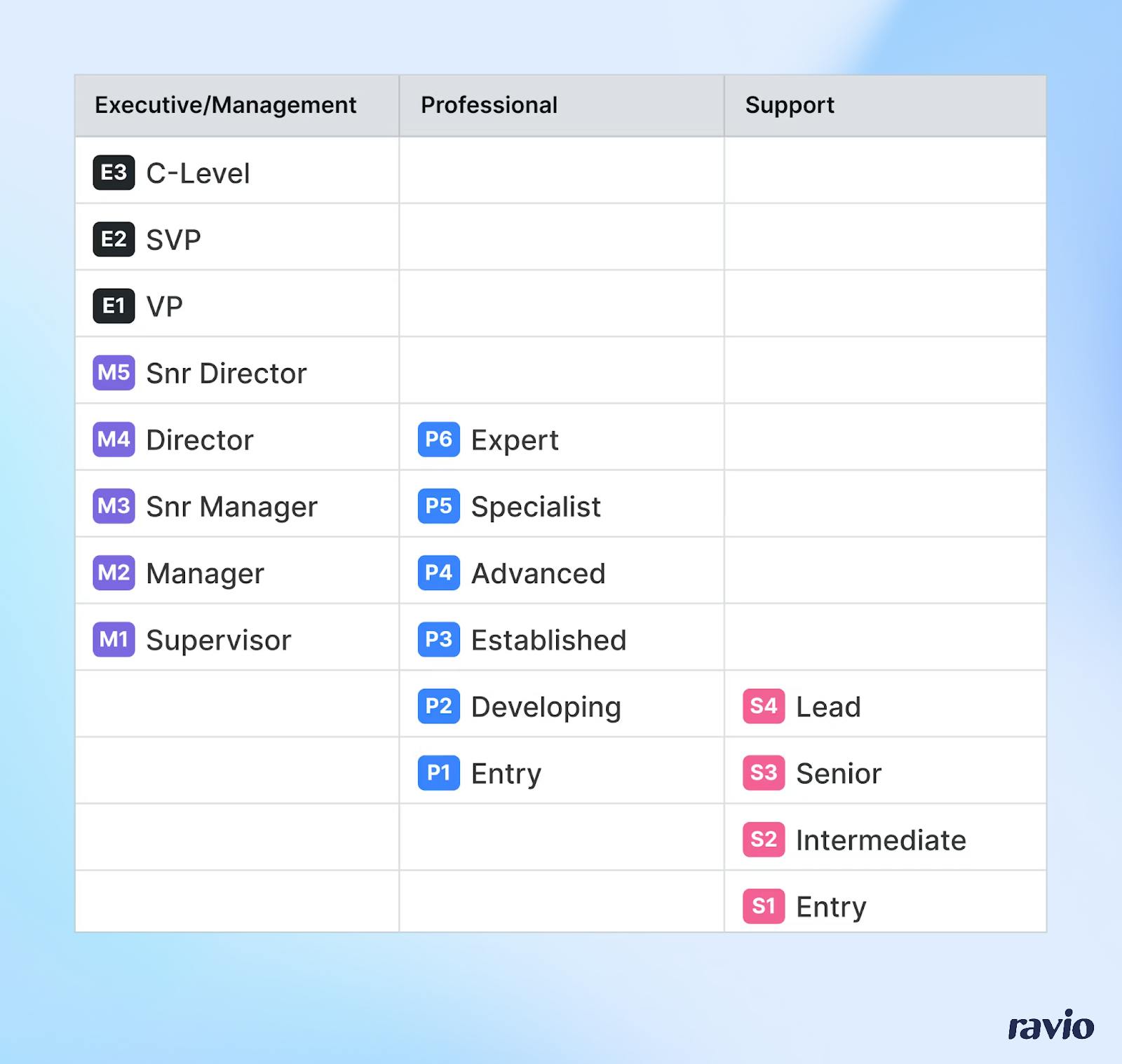
So why have we opted for these levels?
The key principles behind the Ravio level framework:
The three key principles behind the Ravio level framework are:
- It’s universal: fit for any company, no matter the headcount
- It reflects industry best practice for job levels and career progression
- It’s consistent, ensuring relevant compensation benchmarks.
“A great job levelling framework provides employees with the clarity they deserve, helps managers have clear conversations around progression and compensation and means People teams can start thinking critically about the make-up of their organisation.”
1. A universal level framework: fit for any company, no matter the headcount
The Ravio level framework is designed to work for small and large companies alike.
The 12 levels enable clear differentiation between roles and responsibilities as well as well-defined career progression pathways. This amount of levels is suitable even for large companies with 5,000+ employees.
For small startups with only a few levels, the framework can be used throughout the growth journey, simply adding in those additional levels as needed, without being forced to re-do the level framework every time headcount grows.
2. A level framework that reflects industry best practice
We haven’t reinvented the wheel in creating the Ravio level framework, we’ve simply synthesised the most common approaches to evaluating and levelling job roles, into a single effective structure.
Notably, this includes:
- Professional vs Management. In tech companies there should be equal progression opportunities across Professional (otherwise known as Individual Contributor or IC) and Management career tracks – becoming a subject expert is just as valuable for a company as excelling at managing teams. The Ravio level framework reflects this, with parallel career tracks for Professional and Management from P3 onwards. Some benchmarking data providers (especially the traditional consultancy providers like Radford or Willis Towers Watson) have frameworks that still place more emphasis on Management, typically having more levels for the Management than the Professional career track.
- A single set of levels for the whole company. The Ravio level framework is designed to be role agnostic, with one set of job levels used across all job functions and roles. This makes for a clear and simple set of levels which are easy to implement across all teams, avoiding inconsistencies creeping in. Without a clear level framework in place, it can be common for teams to build their own progression frameworks, which makes it difficult to manage compensation and pay equity centrally as a People team.
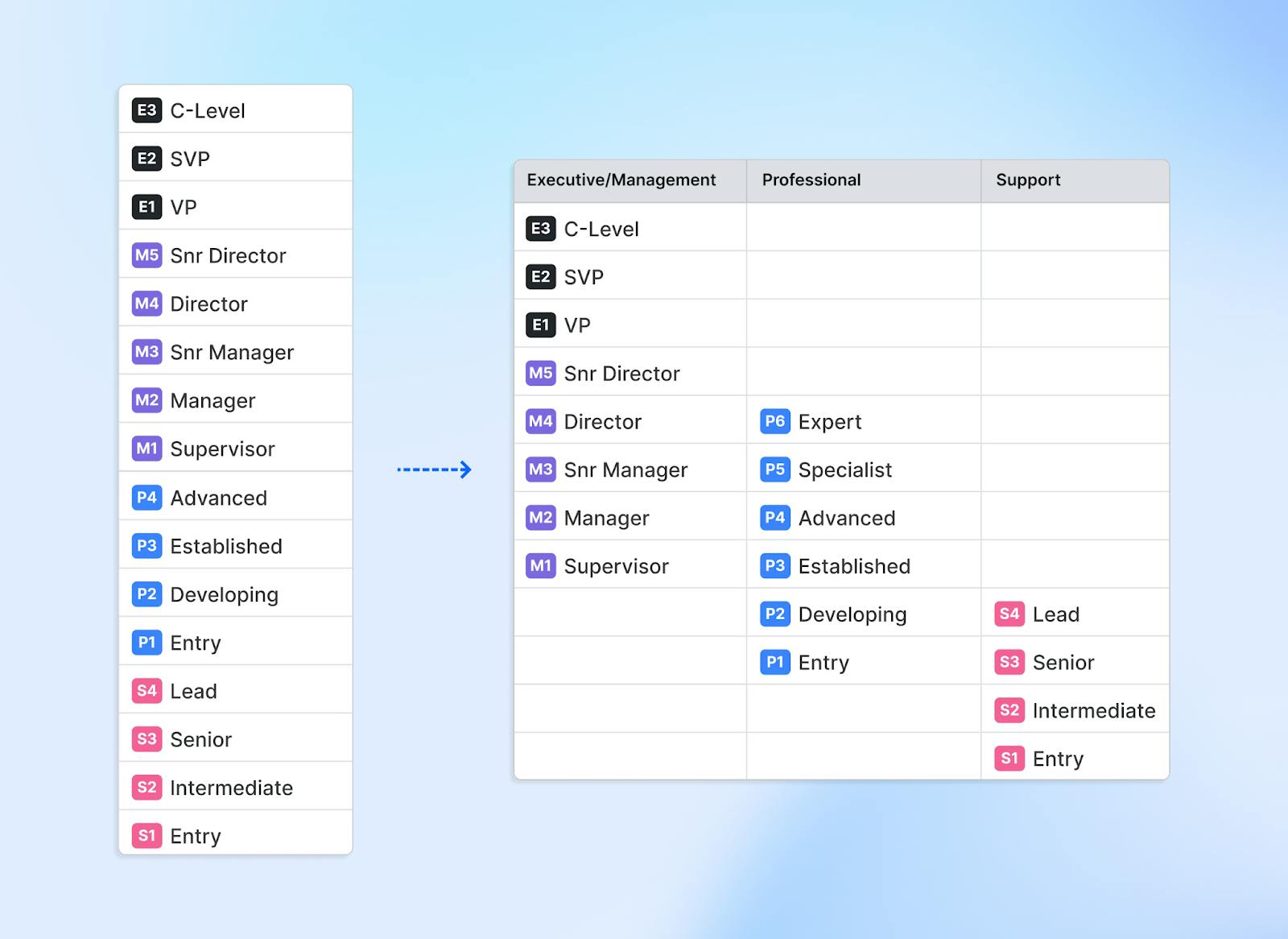
3. A consistent level framework that always produces relevant compensation benchmarks
When you use Ravio for salary benchmarking you need to feel confident that you’re always comparing like-for-like in terms of job levels – that the skills and responsibilities (and, therefore, their compensation package) of your M3 software engineer aren’t the equivalent of someone else’s M4.
Because of this, it’s vital that we have a level framework which produces consistent results when levelling employees across different companies.
The most important factor in this is ensuring that the definition for each job level is clear, logical, objective, and detailed. It needs to be easy to differentiate between levels to ensure fair compensation and progression decisions, avoiding human bias creeping in.
The differentiation between each level should not rely on a number of years of experience – this is typically a poor indicator of an employee’s performance and value.
For the Ravio level framework we use the following key differentiators:
- Leadership: to what extent does the role influence or guide other roles or teams?
- Impact: what effect does the role have on the organisation’s performance or goals?
- Scope: how wide is the subject area or set of responsibilities that the role is accountable for?
- Autonomy: to what extent is the role expected to operate independently or with guidance?
- Expertise: what level of skill or knowledge in the given subject area is expected from the role?
- Complexity: how many and varied are the problems that the role is expected to solve?
So if we compare a P2 to a P3, for example, the difference is defined as followed:
P2 (Professional, developing):
- Expertise: Has working knowledge and experience in own discipline
- Autonomy: Receives moderate guidance and direction
- Impact: Low to moderate impact on success of own function/discipline
P3 (Professional, established):
- Autonomy: works independently with minimal guidance
- Impact: medium impact on success of own function/discipline
- Expertise: has in-depth knowledge of own discipline, acts as a resource for colleagues with less experience – may represent the level at which career stabilises for many years (or until retirement).
Additional versions of the Ravio level framework: starter and single track
There are also two additional versions of the Ravio level framework which are used with some companies to account for the two main variances we come across:
- A single track version with no differentiation between career tracks
- A basic starter version with fewer levels.
The three versions are consistent in how each level is defined, so regardless of which is used your employees are mapped to the Ravio job levels in exactly the same way. The varying versions simply enable us to provide you with information and data within the Ravio platform in the right format and language to fit your internal compensation approach.
Let’s take a closer look at the alternative versions.
Ravio level framework: the single track version
The single track version of the Ravio level framework has one track for all employees, with 12 overall grades and no differentiation between Support (S), Professional (P), and Management (M).
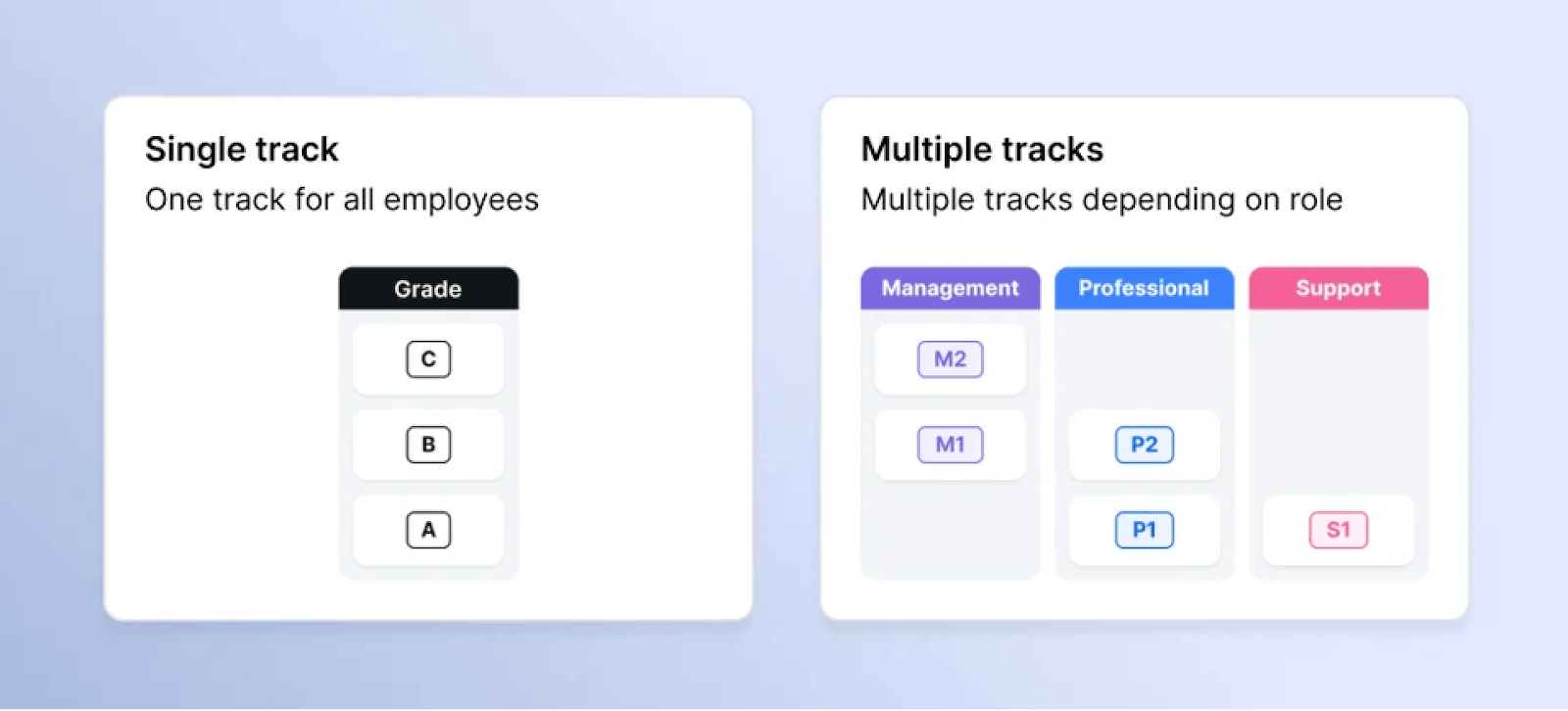
This is a framework that many companies use, especially large companies that have employees across the globe – the standard level framework can vary across countries e.g. Asia vs America and so this single track framework can be a good way to enable a globally applicable approach to job levels.
When you set up your Ravio account you’ll be prompted to choose whether your level framework is single or multiple track.
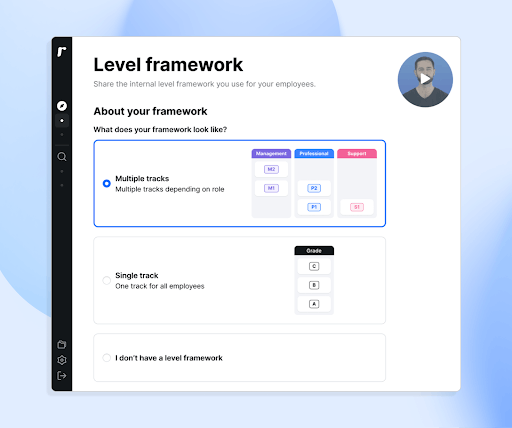
Ravio level framework: the starter version
The starter version of the Ravio level framework has the same three career tracks: Support (S), Professional (P), and Executive/Management (E/M), but only has 8 levels in total.
This reflects the fact that it’s relatively common for smaller or early-stage companies to use a more basic level framework like this one to reflect a smaller headcount (typically <50 employees). Many of the levels simply aren’t used until you have a larger team.
This version of the level framework is used on a case-by-case basis for companies that have many less internal levels than are in the standard Ravio level framework.
If this is the case for your company, when you view the mapping between your company and the Ravio framework in your account, certain levels e.g. P5 and P6 that aren’t relevant to your company won’t be visible. However, the two versions of the level framework are completely compatible, so as your headcount grows and you move to a more advanced framework, we can make those visible.
You can also opt to use the starter version in conversation with your Ravio Customer Success representative.
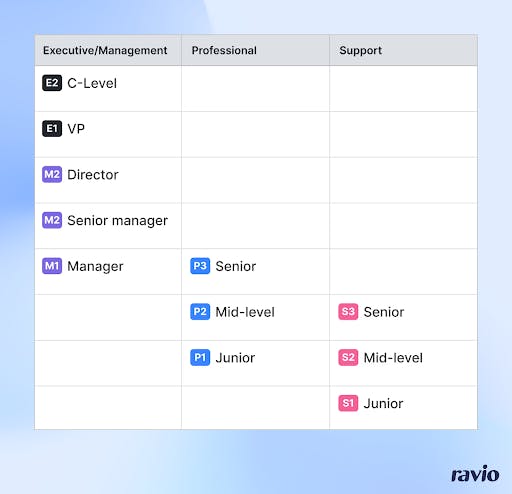
How does Ravio map my employees to the Ravio level framework?
So, we’ve covered why we need to level your employees to the Ravio level framework, and how the framework works.
Now for the final piece of the puzzle: how exactly do we go about mapping your employees to our framework?
Here’s how it works.
During your Ravio onboarding we’ll ask for:
- Information on your internal levelling framework. It can be in any format but it should include details on the competencies and responsibilities required for each level. If you don’t have an existing level framework, that’s all we need to know.
- Each employee’s assigned level. Ideally this would be stored as a field within your HRIS, which is integrated with Ravio during onboarding – this also means that if an employee is promoted or changes role they will be automatically re-levelled in Ravio. However, we can also use an excel or CSV file if needed.
There are then two scenarios:
- If you have an existing framework then we map your level framework to the Ravio level framework
- If you don’t have a level framework we map each of your employees to a Ravio level.
Mapping your existing level framework to the Ravio level framework
If you already have a level framework set up, we simply match up the levels that you use internally to the corresponding level within the Ravio level framework, ensuring consistency between how each level is defined.
A bespoke correlation table is created within Ravio to show you exactly how the two map together.
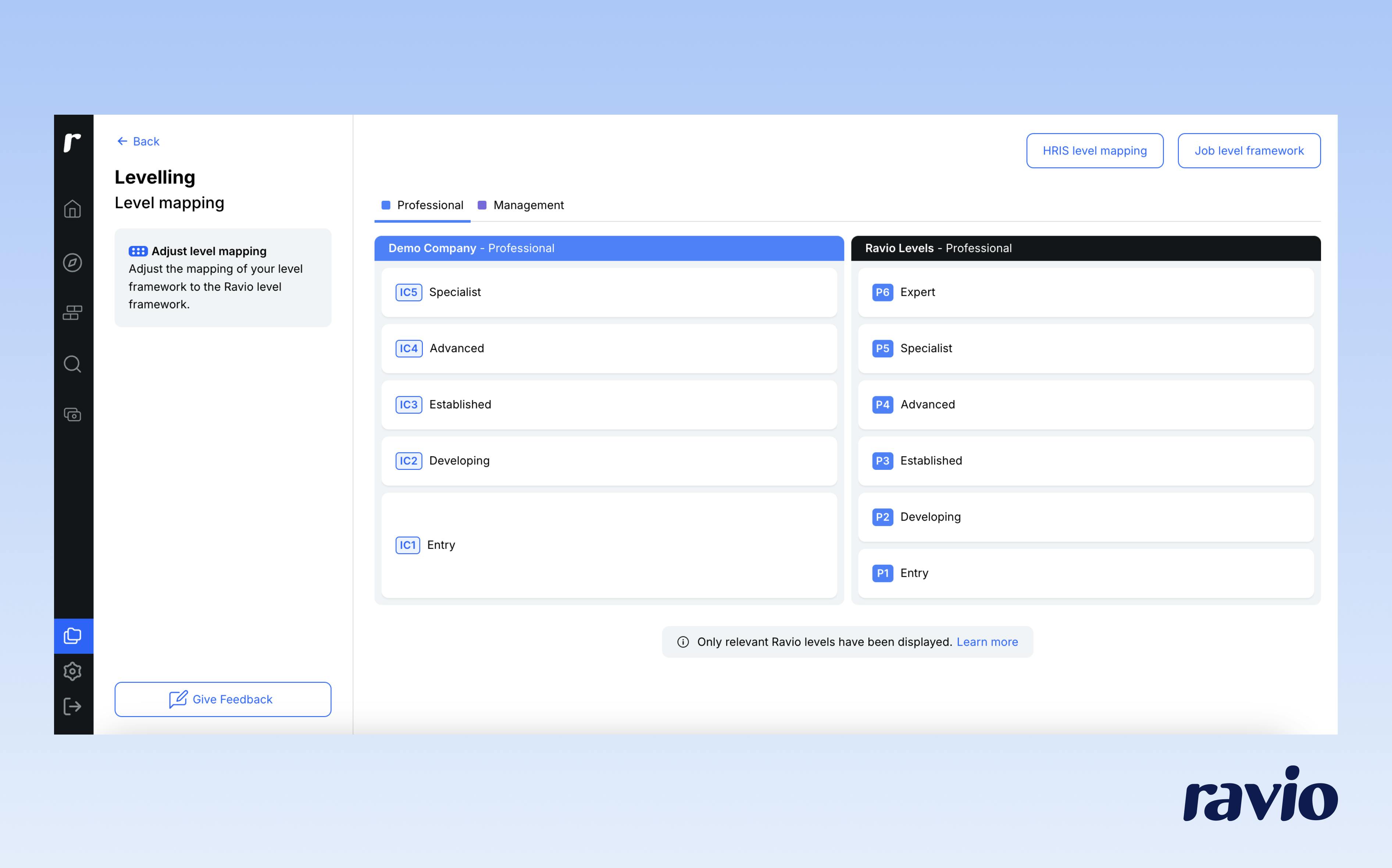
The correlation table is always available to view in your Ravio account under the ‘manage my data’ tab.
It’s also easy to make any manual adjustments here if you feel the mapping isn’t quite right, and any adjustments made to the correlation table will be reflected in the mapping for individual employees.
No level framework: mapping your employees to the Ravio level framework
If you don’t already have a level framework then we essentially create one for you, using the best practice Ravio level framework. This is a huge benefit for some companies as creating and getting buy-in on job levelling can be a long process involving many stakeholders, so this way you have a ready-made set of job levels to use.
Our expert team goes through each of your employees one-by-one and assigns them a level within the Ravio framework.
This is done by analysing the information we’ve gathered on the employees and the overall organisation structure, with some of the key factors including:
- Job title
- Position within the overall org structure
- Reporting lines – identifying what role their manager has, or whether they manage other people or teams themselves
- Company size – smaller companies won’t have some levels e.g. P5 or P6.
It’s then over to you to check the levels we’ve assigned and make any adjustments needed, which is always possible within the ‘Analyse My Company’ section of the Ravio platform.
Typically only minor adjustments are needed. If you have any particularly niche job roles within the company it’s worth checking those. It’s also worth checking any job titles that could cause confusion with levels – particularly the use of ‘manager’ within job titles (e.g. Marketing Manager) where there is actually no people management involved.
Let's get you up and running on Ravio!
To see the platform in action and ask any additional questions about the levelling and mapping process, request a demo.
Other FAQs
In this final section we’ll cover the most common questions that our team hears on this topic of levelling and mapping from the companies we work with.
We have our own level framework, do we have to use yours to join Ravio?
You don’t need to make any changes to your level framework in order to join Ravio.
However, we do need to map your level framework to the Ravio level framework to ensure you can use our compensation benchmarking data accurately. The data that you see in Ravio is based on the Ravio job levels, so if your levels are different to our levels then you won’t get an accurate picture of the market.
For example, you might define an employee as a P3 (or IC3) software engineer and compare their salary to a Ravio P3 software engineer benchmark. But if your definition of P3 is different to ours, then you aren’t actually comparing like-for-like.
We therefore need to understand how your levels match up to the Ravio levels.
For more detail go to the section ‘How does Ravio map my employees to the Ravio level framework?’ above.
We don’t have this many levels, do we have to use all of the levels in the Ravio level framework?
It’s common for companies with a smaller headcount to use fewer job levels. Levels like P6, for instance, are typically only used in larger or later stage companies.
This is always taken into account when we map your job levels or employees to the Ravio level framework and any levels that aren’t relevant won’t be used.
In the correlation table which shows how we’ve mapped your job levels to the Ravio level framework, you will still see all of the levels within our framework. But don’t panic, there will be no employees mapped to the levels that aren’t needed.
We do this so that the process doesn’t need to be redone if you need to add additional levels as your headcount grows.
What is the Support track in the Ravio level framework?
The Support track relates to roles that mainly perform clerical or administrative tasks to support business operations. It’s typical for Support roles to have their success measured based on their hourly/daily/weekly output completing tasks or closing tickets.
Example roles include Customer Support or IT Support. Depending on the industry, this can also include roles focused on manual labour.
Some companies don’t have any job roles that fit within the Support track. If that’s the case for you, then the Ravio Support track won’t be included when we map your level framework to ours.
How many direct reports are needed for someone to be considered a manager?
There isn’t necessarily a set number of direct reports which defines whether a role is a management role or not.
The best way to determine this is to consider how the performance of that role is judged within the business. If performance is judged based on their personal contribution, they are a Professional (or Individual Contributor). If performance is judged based on the contribution of their team, they are a Manager.
What variables are used to determine each level?
The following key differentiators are used to determine each level in the Ravio level framework:
- Leadership: to what extent does the role influence or guide other roles or teams?
- Impact: what effect does the role have on the organisation’s performance or goals?
- Scope: how wide is the subject area or set of responsibilities that the role is accountable for?
- Autonomy: to what extent is the role expected to operate independently or with guidance?
- Expertise: what level of skill or knowledge in the given subject area is expected from the role?
- Complexity: how many and varied are the problems that the role is expected to solve?
What sort of job titles are typically found at each level?
There is a huge amount of variance in the job titles that different companies use for each job level. Because this can be so subjective, it's impossible to provide a set list of job titles that are consistently applied across every company. This variance means that an employee's job title isn't a reliable indicator for their job level.
This is especially true for startups, where job title inflation can be common. A ‘Head of Operations’ at an early stage startup, for instance, could actually be the equivalent of a P3 role at a more established company.
How many years of experience or employee tenure are typically associated with each level?
The differentiation between each Ravio job level does not use ‘years of experience’ or tenure. This is because the number of years of experience or tenure of an employee is typically a poor indicator of their performance and value.
Instead, each level is differentiated based on skills, competencies, and responsibilities, with six key indicators mentioned above: Leadership, Impact, Scope, Autonomy, Expertise, and Complexity.
Why are some Professional salaries higher than some Management salaries in Ravio’s salary benchmarking data?
When you view salary benchmarking data in the Ravio platform you will see that salaries increase up to P6, and then drop back down at M1.
This is because Professional and Management are two separate, but parallel, career tracks within the Ravio level framework – as you can see in the image below.
This view of the Ravio level framework is always available within your account in Explore the Market > Base Salary > Guide.
A P3 is typically in line with an M1 (though there is some slight variance depending on role) in terms of job level, and the salary benchmarks reflect this.




